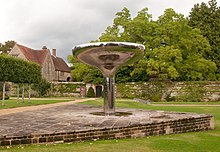| Woolbeding House | |
|---|---|
 | |
| General information | |
| Type | Country House |
| Location | Woolbeding, West Sussex, England |
| Coordinates | 50°59′50″N 0°45′25″W / 50.997196°N 0.757052°W |
| Completed | 1760 |
| Designations | Grade I listed |
Woolbeding House is an 18th-century country house in Woolbeding, near Midhurst, West Sussex, England. It is a Grade I listed building. [1]
It was probably built by Sir Richard Mill Bt between 1711 and 1760 and was originally of a quadrangular plan with an open courtyard in the middle. The courtyard was later roofed over. The house is built of coursed Hythe sandstone in 2 storeys with an attic and has a 7-bay south-facing frontage with 5 hipped dormers.
History
The manor of Woolbeding belonged to William Aylyng in 1567 and passed by marriage to the Grey family. The Greys owned the manor until Margaret Grey married Sir John Mill in 1652. It then passed down in the Mill family until 1791, the manor house having been remodelled by Sir Richard Mill in the meantime. [2]
In 1791 the Rev. Sir Charles Mill, 8th Baronet sold the house and estate to Lord Robert Spencer, the youngest son of the 3rd Duke of Marlborough, who immediately made a number of alterations to the house, including the roofing over of the central courtyard. The house then descended in the Spencer family via his stepdaughter Diana Bouverie to her daughter, who bequeathed it to the Lascelles family. They in turn made it over in the late 1940s to the National Trust, who leased it to businessman, philanthropist and art collector Simon Sainsbury until his death in 2006. His partner Stewart Grimshaw remained in occupation afterwards.

A feature in the gardens is the Cedra fountain by the artist Walter Pye, which stands on the spot once occupied by a venerable cedar tree. The gardens have been open to the public since 2010.
Woolbeding Gardens
Over the past 5 decades Simon Sainsbury and his partner Stewart Grimshaw collaborated with renowned designers such as Lanning Roper, Julian and Isabel Bannerman, Philip Jebb, and more recently, Thomas Heatherwick to transform the Woolbeding Gardens into the vibrant horticultural paradise it is today, now open to the public.[3]
Visitors are greeted by the Entrance Garden, a beautifully transformed area that was once the old farmyard. Julian and Isabel Bannerman redesigned this space to feature a dry garden with formal water pools, surrounded by informal perennials and olive trees. The Bannermans also developed the Pleasure Grounds area as well as The Long Walk; a circular route which features delightful follies that lure visitors around the garden.[4]
The Glasshouse and Silk Route Garden was designed by Heatherwick Studio for Woolbeding Charity, supported by the National Trust. The ten-sided kinetic glasshouse and landscaped garden zones showcase plants, shrubs and trees that represent the key regions of the Silk Route.[5]
References
- ↑ Historic England. "Woolbeding House (1221573)". National Heritage List for England. Retrieved 28 October 2018.
- ↑ "REPORT ON THE HISTORY OF WOOLBEDING HOUSE AND GARDENS" (PDF). Sussex Garden Trust. Retrieved 28 October 2018.
- ↑ "Visiting Woolbeding Gardens | West Sussex". National Trust. Retrieved 30 April 2023.
- ↑ "History of Woolbeding Gardens│W Sussex". National Trust. Retrieved 30 April 2023.
- ↑ "Woolbeding Gardens glasshouse │West Sussex". National Trust. Retrieved 30 April 2023.